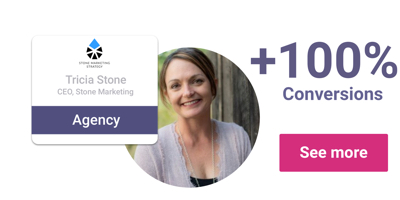
What is a CTA (call to action)? The term is commonly used, especially in connection with marketing, but there’s a certain art to crafting the perfect call to action. In very simple terms, a call to action is simply a statement that you use to get a direct, immediate response from whoever is reading or hearing it. The content and nature of the statement varies greatly depending on the type of response you are aiming to receive.
While this concept might sound simple in and of itself, failing to implement a killer call to action can make your marketing campaign or material a total flop. This is why it’s crucial that you learn how to make and implement a strong call to action and do so as part of every sales process that you develop and initiate.
Ultimately, your call to action should make the audience feel a certain way, and it should ideally target a particular need that they have. This article discusses the features of a great call to action, how they work, and how you can and should implement them whenever you create marketing materials.
Generate better leads to grow your sales
Discover new strategies to unlocking a flood of high-quality leads from your website.

Using a CTA
What is a call to action? A CTA should ultimately be the factor that sinks the product you’re selling to your audience. Your CTA can focus on the importance of the product, its quality, or your audience’s pain points. Regardless of how you choose to structure your CTA, all strong calls-to-action have certain characteristics in common.
You generally implement a CTA towards the end of your marketing strategy or materials or at a later stage of the pitch, if there is one. Your CTA is going to work best if you have already explained the product in some depth to the audience. Fail to do so, and you’re unlikely to succeed in motivating your audience to take action. If they don’t know why they need your product, why should they respond to what you say?
Some business owners make the mistake of omitting a CTA in their materials or pitch. One common reason for this is the belief that their product is so strong or easy to sell that they don’t even need a call-to-action. While confidence is a fantastic attribute to have, it isn’t helpful in this instance.
Assuming that your entire audience sees the value in your product just as much as you do can result in you missing some key sales or conversions. Having a targeted strategy for a higher conversion rate can often make an enormous difference to your overall sales. This is why it’s crucial that you go into any pitch and always create marketing material with the right mindset.
Don’t be Afraid to Sell
Another common reason for business owners to omit CTAs from their pitch or marketing is that they feel a CTA is aggressive or obnoxious. They might be afraid of turning away potential customers by coming across the wrong way. While this attitude is noble, it is a little misguided. Once you know how to write a great call to action, you don’t need to worry about rubbing your audience the wrong way.
You can word a CTA in such a way that it’s convincing without feeling ‘salesy.’ A CTA can be subtle but still effective. Having an audience-centered approach to marketing is possible, and it can be very successful. All you need to do is ensure that you’re familiar with your audience and what they expect. This way, you can tailor your approach to writing a CTA accordingly, ensuring that you maximize your conversions without alienating any of your potential customers.
The Psychology of a Call-to-action:
Why are CTAs Important?
You might still be wondering, ‘why are CTAs important?’ In short, they’re often a crucial part of the conversion process. A strong CTA is a crucial point for bridging your pitch and conversions. It can also be genuinely informative. If your audience has read through your pitch or materials and wants to learn more, then a good CTA can direct them on what to do next.
If you work in marketing and want to help your clients improve their conversions, having a CTA is basically a non-negotiable. Featuring a head-turning message in your clients’ materials is crucial, and a strong CTA is often what seals the deal. A weak or ineffective CTA might leave your clients’ audience wondering why they actually need the product or unsure of how to purchase or engage it.
It often helps to think of successful sales as taking place in a ‘funnel’ process. This is a common metaphor in sales psychology, and structuring your marketing and sales this way is nearly a guarantee of success. Essentially, once your audience has been led through a process of understanding your product and why they need it, your CTA is the last nail in the coffin.

How Does CTA Help Generate More Leads?
Your CTA is an essential part of the lead generation pathway. If you want to keep it simple, a CTA can be as simple as a link to your website, blog, or product. Marketers or business owners concerned with coming across as too aggressive in their marketing may prefer this approach to displaying a CTA.
The way you structure your CTA directly how it influences your audience. If you’re aiming to focus on lead generation, you can develop a CTA explicitly for that purpose. A lead-generating CTA might differ from a CTA that aims to drive conversion rates up, but the general principles are the same.
For example, if you want to develop a CTA specifically for lead generation in the context of blogging, you can work it into the conclusion paragraph. A CTA used in this way could drive more users to your business or your clients’ products if you work in marketing.
It’s important that you utilize high-quality leads in your marketing. One quality lead is far more valuable than several that are less dependable. Your CTA is the step that transforms lead generation into conversion. Once you’ve done the hard work building up a product or service, all you need to do is provide your audience with an opportunity to purchase or get started with using it.
How to Write a Great Call to Action: Three Examples
If you’re wondering how to write a great call to action, then utilizing these principles should be a great place to start. Still, if you need more ideas, you could try implementing one or all of the following examples in your or your client’s materials. Using a CTA wisely can help you generate a high-conversion landing page, attract more clients or customers, or build your network.
Using a link to download content is a great example of a CTA for businesses that want to distribute information about their products or activity as much as possible. The material that you offer for download could be a brochure or pamphlet that explains what you do in greater detail, for example. Once you’ve sold your audience on the importance and relevance of your services, a pamphlet going into more detail can cement your legitimacy and drive up your conversion rate.
CTAs can be specific to a particular time or season. One fantastic way to implement CTAs is through offers in connection to public holidays or celebrations. For example, you might want to come up with a Halloween campaign and use a Halloween-themed CTA. This is even more effective when you introduce something that inspires a sense of urgency in the audience. If the offer or material expires by a certain date, make sure to emphasize this in the CTA.
Encouraging your audience to keep in touch with you or follow your activity over the long term is a fantastic way to build up a passive network of customers. Using a CTA can help with this. You can develop a CTA that allows users to join your email list or subscribe to your website, blog, or YouTube channel, for example. This is a fantastic way to ensure passive interest in your company or clients over the longer term.
The main thing to ensure with CTAs is that everything you produce has at least one clear CTA that stands out from the rest of the content. If sales and results are important to you, then using a CTA needs to be a priority of yours or your clients. The type of CTA and its structure can vary, but including a CTA is a non-negotiable when creating any kind of marketing material or pitch.
What is a call to action? Calls-to-action are a crucial part of marketing and sales, but they aren’t well-understood by all. Some business owners leave CTAs out of their marketing materials altogether for fear of coming across as salesy or aggressive. However, a CTA is an essential element of a successful marketing or sales strategy. You can tailor your CTA so that it reflects the ethos and image of your business or that of your clients. However, you must always include at least one CTA in your marketing and sales materials.
Understand your customer journey analytics
See how your users behave, find drop-offs, and receive actionable insights with AI.










